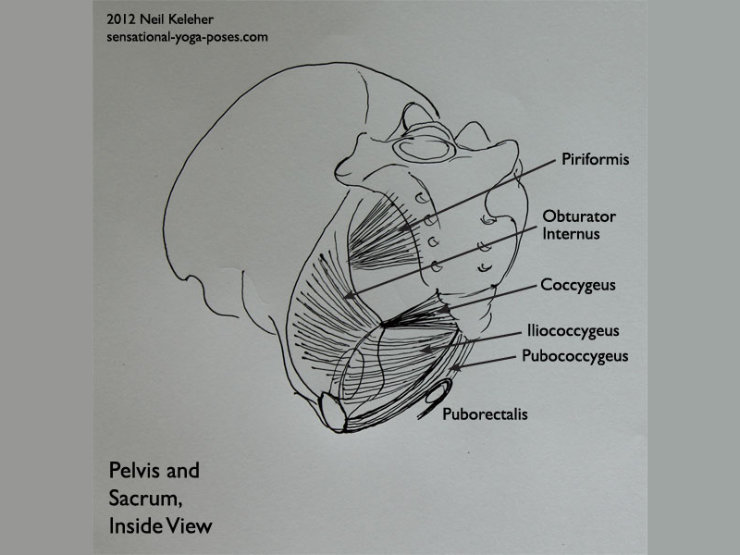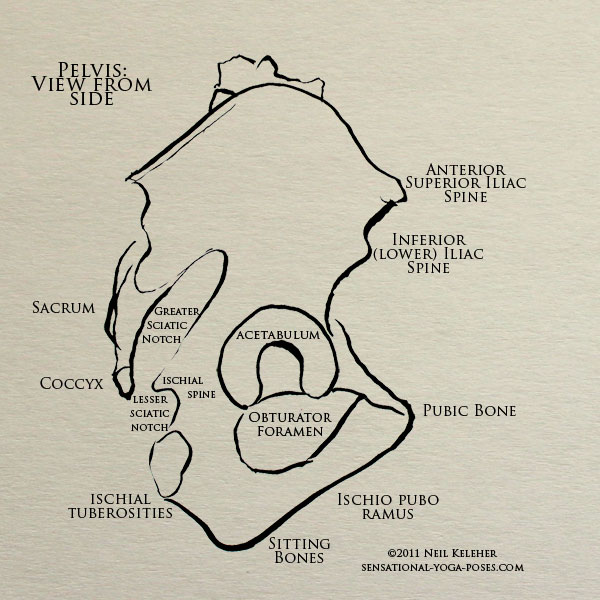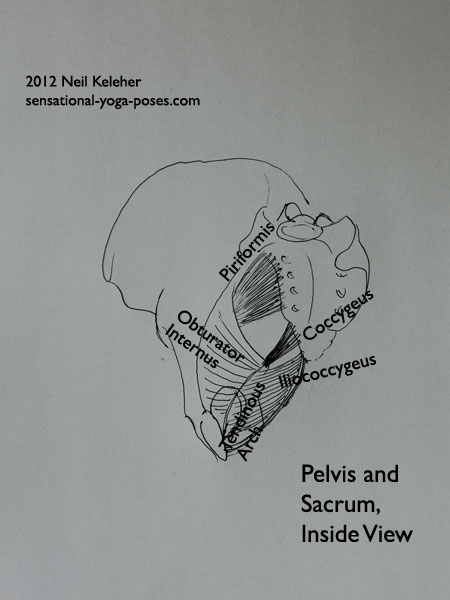The Sacrum
and the Muscles that Connect it to the Legs, Spine and Pelvis
The sacrum is an arrow shaped bone that points downwards between the buttocks. It forms the bottom most element of the spine and connects the spine to the pelvis. The bottom tip of the sacrum is formed by the tail bone.
The sacrum is made up of five vertebrae that are fused together. You could think of it as a spacer. It creates space between the back of the two hip bones potentially allowing them greater freedom to move and adjust relative to each other.
What muscles attach to the Sacrum?
Muscles that attach directly to the sacrum include:
- the piroformis and
- some fibers of the gluteus maximus
- the spinal erector muscles.
- and also the multifiddi
("Directly" attach might be a bit of a misnomer. By direct I mean muscles that have connective tissue attachments that connect to the sacrum and through action or relaxation can affect the relationship between the sacrum and the pelvis as well as that between the sacrum and the rest of the spine.)
What muscles attach to the tailbone?
Because the connection between the sacrum and tailbone is relatively stable (and because the tailbone has no other direct bony attachments) it could be useful to also think of muscles that act on the tailbone as muscles that also can affect the sacrum and the aforementioned relationships between it and the pelvis and itself and the other elements of the spinal column.
The muscles that attach to tailbone (and thus can have an affect on the sacrum) include:
- the pubo cocygeus muscle as well as
- cocygeus, and
- iliococygeus.
How do you activate the piroformis muscle?
The piriformis attaches to the front surface of the sacrum and from there passes through the upper sciatic notch at the back of the pelvis to attach to the back of the thigh.
To directly contract this muscle you can imagine sucking forwards on the sacrum. To increase the likely hood that it is the piriformis that you are activating, you can try moving the sucking sensation upwards slightly (or a lot) but keep it below the top rim of the pelvis. In addition you can imagine the vectors of this sucking force to reach out to the sides instead of straight forwards.
And for most effective "sucking" activate and release. By rhythmically and smoothly activating and releasing you are more likely to be able to feel your sacrum pulling forwards and you may also be able to easier notice any differences in tension between sides.
How do you activate the sacral fibers of the Gluteus Maximus muscle?
The fibers of gluteus maximus that attach to the sacrum attach to the back along the edges of the arrow head. These fibers may attach to the tensor fascia latae which in turn attaches to the iliac crest (the rim of the bowl of the pelvis) and the outside of the top of the lower leg bone. Or these fibers attach to the back of the thigh bone.
To activate these fibers you can imagine pulling back and out (following the outer curve of the buttocks) on the edges of the sacrum.
When doing this try to sit up reasonably straight and balanced between both sitting bones. And here again, pulse the activation and see if you can spot any differences between the sides.
How do you activate the sacral Spinal Erector muscles?
The fibers of the spinal erectors attach to the back of the pelvis, to the back surface of the sacrum. They reach upwards from there to attach to the back of the spine along its length as well as the backs of the ribs.
You may be able to partially activate fascicles (muscle bundles) by pulling (or sucking) back and upwards on the back of the sacrum.
Try doing this with a straight lower back and also with your lower back bent backwards (bend around an object behind you) and bent forwards.
How do you activate the pubococcygeus muscle?
Pubococcygeus connects the tail bone to the pubic bone.
You can activate this muscle by pulling your tail bone towards your pubic bone while keeping your pelvis still. For increase sensation you can also try pulling your anus towards your pubic bone. (This more than likely activates puborectalis.)
How do you activate the Coccygeus muscles?
Coccygeus attaches from the tail bone to the ischial spines. These are peaks of bones that separate the upper sciatic notch from the lower. They are roughly just above the sitting bones (or ischial tuberosities) the bones you can feel when you are sitting on a hard seat. (if you can't feel them, trying rocking your pelvis back until you can.)
To activate these muscles, try pulling the sitting bones inwards and back towards the tail bone.
How do you activate the Iliococcygeus muscle?
The iliococcygeus fans out from the tail bone to attach to the inside of the bowl of the pelvis (actually to the tendinous arch).
The span the bottom of the pelvis from the coccygeus almost to the pubic bone. If you start of by contracting yoru coccycgeus, you can then extend this contraction forwards, towards the pubic bone to then activate coccygeus.
Muscle Activation General Points
I'd suggest that for all of these muscle activations, control of the sacrum (and the si joint) is best achieved through being both able to relax and contract these muscles.
And so if you do choose to practice activating these muscles, at least till the point that left right balance is achieved, practice doing both relaxation and contraction smoothly and slowly. And for maximum effectiveness try them while sitting, standing, laying down (on belly, back, on left side and right side.)
You can also practice them as part of your breathing exercises either activating with your inhales and relaxing while exhaling or vice versa.
Published: 2020 08 14
Updated: 2020 11 04





